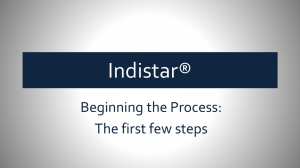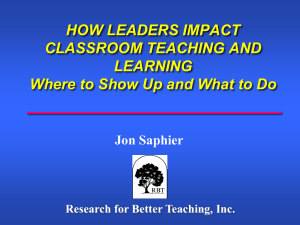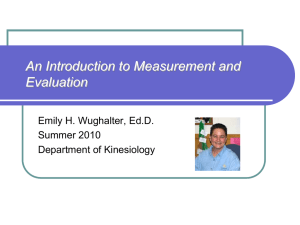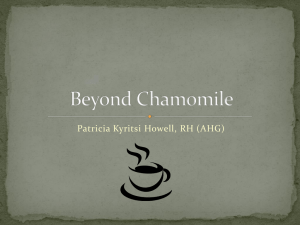Teddy St Patrick - Behavior Doctor
advertisement
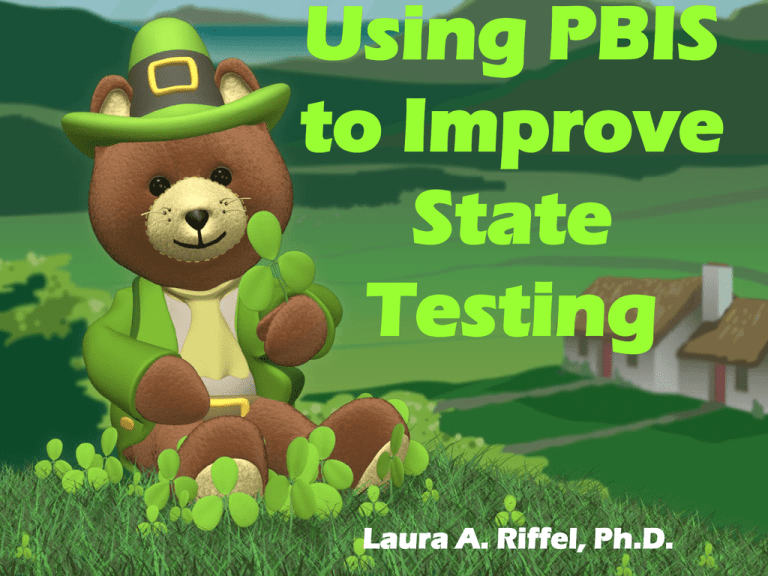
Using PBIS to Improve State Testing Laura A. Riffel, Ph.D. Study your history What have been your strengths in the past? What have been your needs? Look at your data How do we communicate the test to students? Student motivation to do well on the test Even though the testing itself is academic- the motivation is a behavior issue. PBIS MODEL TEACH IMPRINT PRACTICE TeachReinforce and practice Good test taking strategies PRAISE Why don’t the students do well? Why don’t the students do well? Writing Activity Research: Writing about worries eases anxiety and improves test performance January 13, 2011 Students can combat test anxiety and improve performance by writing about their worries immediately before the exam begins, according to a University of Chicago study published in the journal Science. Researchers found that students who were prone to test anxiety improved their high–stakes test scores by nearly one grade point after they were given 10 minutes to write about what was causing them fear, according to the article, “Writing about Testing Boosts Exam Performance in the Classroom.” The article appears in the Jan. 14 issue of Science and is based on research supported by the National Science Foundation http://news.uchicago.edu/news.php?asset_id=2210 Writing Activity Use the penagain.com pencil- it’s number 2 lead Science Improves Test Scores Go to bed early the night before. Sleeping only six hours instead of eight increases levels of the stress hormone cortisol by 50%, and sleep- deprived people score 30% lower on memory tests. Science Improves Test Scores Don’t skip breakfast. Students who eat breakfast score higher on tests and report less test-related anxiety. Best bets? Eggs for brain-boosting choline, and oatmeal for a calming increase in serotonin levels. Science Improves Test Scores After your healthy breakfast, treat yourself with a little dark chocolate. It boosts memory, alertness, and concentration, and its special chemicals even decrease anxiety. Science Improves Test Scores Pop a stick of gum. In one British study, the act of chewing was found to activate the hippocampus, the brain area responsible for memory, improving recall by 35%. Science Improves Test Scores Mint scents increase alertness, leading to fewer mistakes. Science Improves Test Scores Put a bit of fresh rosemary in your pocket on test day—it’s a proven memory booster! In fact, in ancient Greece, students wore sprigs of rosemary in their hair on exam day. Science Improves Test Scores Use this acupressure trick: Press the spot on your wrist about two thumb widths down from the base of the palm. Acupuncturists believe this signals the heart to slow to a more soothing rhythm. From www.braingym.com Carla Hannaford says, “Drink” …Water comprises more of the brain (with estimates of 90%) than of any other organ of the body." Having students drink some water before and during class can help "grease the wheel". Drinking water is very important before any stressful situation tests! - as we tend to perspire under stress, and de-hydration can effect our concentration negatively. Science Improves Test Scores Bring a bottle of water with you to the test. Even the slightest dip in hydration levels can lead to stress, memory loss, and a drop in mental functioning. From www.braingym.com "Brain Buttons “ This exercise helps improve blood flow to the brain to "switch on" the entire brain before a lesson begins. The increased blood flow helps improve concentration skills required for reading, writing, etc. Put one hand so that there is as wide a space as possible between the thumb and index finger. Place your index and thumb into the slight indentations below the collar bone on each side of the sternum. Press lightly in a pulsing manner. At the same time put the other hand over the navel area of the stomach. Gently press on these points for about 2 minutes. From www.braingym.com "Cross Crawl “ This exercise helps coordinate right and left brain by exercising the information flow between the two hemispheres. It is useful for spelling, writing, listening, reading and comprehension. Stand or sit. Put the right hand across the body to the left knee as you raise it, and then do the same thing for the left hand on the right knee just as if you were marching. Just do this either sitting or standing for about 2 minutes. "Hook Ups“ This works well for nerves before a test or special event such as making a speech. Any situation which will cause nervousness calls for a few "hook ups" to calm the mind and improve concentration. Stand or sit. Cross the right leg over the left at the ankles. Take your right wrist and cross it over the left wrist and link up the fingers so that the right wrist is on top. Bend the elbows out and gently turn the fingers in towards the body until they rest on the sternum (breast bone) in the center of the chest. Stay in this position. Keep the ankles crossed and the wrists crossed and then breathe evenly in this position for a few minutes. You will be noticeably calmer after that time. Bubbling can be stressful Every day have a question on the board (white board or smart board) Have the students bubble in their answer to the question on the board What do you have for pets at home? Dog Cat Fish Guinea Pig Hamster Rat Snake Put in age appropriate questions- this is just an Why don’t the students do well? I Want YOU to do well on the test. Ask me how I can help you. Family Night: • Each family comes up to the school with all their children. • Each family chooses a game board design and creates it together. • Coloring, stickers, laminating etc. • Each family is given the following: • Flash cards appropriate for each grade level’s test review questions • Pawns • Dice Give each student their previous years’ test scores and have them determine which areas they want/need to improve: Offer after school “clubs” for all of the areas: • • Monday- reading • Tuesday- math • Wednesday- writing • Or • Mrs. Jones (Monday- Wednesday) 3 grade reading • Mrs. Smith (Monday-Wednesday) 3 grade math • Mr. Phillips (Monday- Wednesday) 3 grade writing rd rd rd Put test review questions on a ball and toss the ball around the students in a circle. Where their right thumb lands- that is the question they have to answer. http://www.apple.com/education/itunes-u/whatis.html Share your lessons on I-pods (most students have one) $28.34http://tinyurl.com/eggsp ert http://www.jc-schools.net/tutorials/PP http://facstaff.uww.edu/jonesd/games Play More Ten minutes of non-violent games quickens your thought processes. This lets you make decisions and see connections faster. Bonus: These games distract you from anxieties; which hampers quick thinking. Teach Test Question Types Right There- the answer is right in the question. Think and Search- the answer is in more than one place. You and Author Questions- The answer comes from you based on what you read. Give examples and color code the questions – RED= Right There Questions TURQUOISE= Think and Search Questions YELLOW= You and Author Questions This will give students the confidence to tackle the test. Teach Test Taking Strategies: Teach students about story organization, compare and contrast, cause and effect, and other text structures that are important parts of both literacy training and test preparation. Many test passages are written in a standard format. When students understand that format it will give them a head start in reading passages and locating answers. Students need to be efficient. We don’t want to waste time rereading passages until we come across answers. Test Taking Tip: After reading a story passage with an obvious beginning, middle, and end, have the students guess which part will hold the answer to the comprehension question. These are the typical patterns: The Beginning section typically holds information about when and where. The Middle section typically holds the answers about the problem of the story. The End section typically holds the clue to how the problem was solved. Knowing this information will save students time and give them confidence to do well on the test. Math Story Problems Give all the students a tiny magnifying glass and send them around the school in pairs as “Super Spies” . Have the students go around the school and write two math story problems from around the school. Give them a few examples. Example: “There are 3 classes of third grade. One class has 25 students, one class has 23 students and one class has 26 students. What is the average number of third graders in a class?” Type up all the story problems and use them to teach the students how to work story problems. Remember Dead Week????? Remember Dead Week in College??? No homework the week before At my university during dead week life was dedicated to studying and no new homework. Certain shops offered “dead week” incentivesdonuts- coffee- etc.- Set up carts around the school after school for study sessions- study breaks. Parents were given opportunities to send “goodies” to students away at school. Offer an opportunity to send notes to students during day at school. Tips on answering multiple choice questions Read the question before you look at the answer. Come up with the answer in your head before looking at the possible answers, this way the choices given on the test won't throw you off or trick you. Eliminate answers you know aren't right. Read all the choices before choosing your answer. If there is no guessing penalty, always take an educated guess and select an answer. Don't keep on changing your answer, usually your first choice is the right one, unless you misread the question. In "All of the above" and "None of the above" choices, if you are certain one of the statements is true don't choose "None of the above" or one of the statements are false don't choose "All of the above". In a question with an "All of the above" choice, if you see that at least two correct statements, then "All of the above" is probably the answer. A positive choice is more likely to be true than a negative one. Usually the correct answer is the choice with the most information. http://www.testtakingtips.com/test/multiple.htm Test Your Memory: Now You See It: Now You Don’t Set up a table in the classroom and put 20 objects on it of varying interest. Have all the students look at this for 30 secondsthen cover it up with a sheet. Have the students list everything they remember seeing. This will improve their brains in using their visual and language areas. (Shelley Carson, Ph.D. 2011) Why don’t the students do well? How Does Your Engine Run???? http://www.alertprogram.com/ Test Taking Strategies to Help with Anxiety Hughes, C., Schumaker, J. Deshler, D. and Mercer, C. (1993).The Test-Taking Strategy. Lawrence, KS; Edge Enterprises, Inc. P I Prepare to Succeed Write name on test and put the word PIRATES on top of the test Preview the Test Rank the sections of the test from easiest to the hardest Start the test within 3 minutes that it was given Inspect the Instructions Read the Instructions Separately Underline what to do and where to respond R A T E S Read, Remember, Reduce Read the entire Question Remember what you studied Reduce your choices; eliminate obvious wrong answers Answer or Abandon Answer the Question Abandon the Question for a moment Turn back, go back and answer any questions that you skipped Estimate your answer Avoid Absolutes Choose the Longest or most Detailed Choice Eliminate Similar Choices Survey to ensure all questions are answered Switch an answer only if you are positive it is correct Be a Smart Cookie…. Answer all the easy questions first in the test section. Knowing you know something raises your confidence to handle the ones you aren’t quite sure about. Crank up some lively music Upbeat songs increase levels of dopamine. Being in a good mood inhibits parts of the brain that are “negative and critical”. (Shelley Carson, Ph.D. 2011) You will be better able to come up with creative solutions if you are in a good mood. It is easy being green…… Show 7 minutes of images of land, sea and sky. Nature’s restful effect can enhance memory and attention by 20% ( University of Michigan study) Why don’t the students do well? SelfAffirmations Self-Affirmations I am good enough to ace this test. I deserve to pass this test with flying colors. I will do well on this test. I am capable. I am awesome. I’m dependable. I will get enough sleep before the test. I will eat a good breakfast on the day of the test. I will hydrate my body so I do well on the test. I will exercise my brain, so I do well on the test. I will practice my breathing so I am cool, calm and collected for this test. Self-Affirmations Play “Four Corners”(hang signs in the corners of the room) Ask questions like this: There are _____ feet in a mile? A. 4,365 B. 5,280 C. 5,365 D. 1,000 Students go to the corner of the right answer- fun way to practice bubble tests. Have students take their other tests as bubble tests to practice taking bubble tests. Spelling: Which is correct? Sunnshine Sunshine Soonshine sunshin o o o o Why don’t the students do well? Let students build an office using their favorite color folder to put up as a visual screen so they don’t have any visual distractions. Feng Shui for the Classroom To Increase Knowledge Blue • Blue: Blue is considered an inward-focusing color and works well here. From the wall paint to the lampshade, add a little blue to increase the brain vibes. To the left inside your classroom door put a picture of: Merlin, Albert Einstein, Mozart, or Gandhi. Whose wisdom would you like your students to emulate? Create a quiet space • This is not a punishment area. This place should be away from distractions and have a comfortable chair or bean bag. There should be some restful pictures and a pair of headphones for the student to block out unwanted noises. • Think “spa”- outside the quiet area have a water feature, lots of plants, extremely soft music playing 60 beats per minute music. Clear all clutter To Increase Creativity Metal • To the right inside the front door of the classroom and about 1/3 the way back have something metal. This could be a metal plant container, metal picture frames with pictures of children, or some metal decoration. • White: Look for white round things to put in this area. White metal clock, a round table with a white top or white topper. • Store games in this area- chess, checkers, whatever you use for those who finish work early. • Do not have anything red in this area of the classroom. To Increase Helpfulness Silver • Right inside the front door to the right have a silver box- this can be a shoe box filled with aluminum foil if you have to. • Use this box for class meetings to have students write down and place anonymously the issues they are dealing with and would like help on. Hands • Have cut outs of hands in this area. Put the student’s names on the hands. You can use this to dedicate teams or hours or sections of your class- but put every student’s name on a hand. • There can be more than one name on a hand if you teach secondary. Symbols of helpful beings • Place books in this area highlighting helpful actions. These could be books on: – – – – Community service Bully-proofing activities Jobs in the helping fields Making friends Globe and Bell • Put your globe in this area or pictures of distant travels. • Place a bell in this area. This can be an old school bell or a wind chime hanging above. To Increase Relationships Wood Columns and Pictures • In the center left of the room place something wood in a round column shape. This could be a small wood table, a small tree, or a wood plant stand. • Place plants in this area. • Place pictures of your students in this area in group pictures. To Increase Career Mirrors, Water, Black, Glass • To increase your career place these things near the doorway of your classroom – Mirrors which equal water or a water feature like a mini fountain – Anything black in this area – Glass- like glass flower vases filled with water and flowers – Pictures of your career dreams • You can put student career dreams here as well.




